 You are the captain of your drinking ship. You are the captain of your drinking ship. Would you say weather plays an important role in setting the tone for your choice of an earthy or fruity wine? For instance, here in San Francisco, we are experiencing twenty-five-mile-an-hour winds and, for some, subsequent power outages. I can tell you that my run at forty-three degrees Fahrenheit this morning in Golden Gate Park was nothing short of invigorating. Peter called out “good luck” as I leapt forth into the wild outside. I had a psychological advantage, though: friends had sent photos of themselves enjoying time with their families in several feet of snow. That’s why today’s run was totally in my wheelhouse. Tonight the wine will be a nice earthy red, maybe a Nero d’Avola, to keep a late winter’s brisk weather at bay. A quick look into the wine fridge reveals the perfect candidate: a 2017 Cerasuolo di Vittoria by Donnafugata, a spicy blend of Nero d’Avola and Frapatto out of Sicily. As we are having this conversation, I have been deciding whether to cook tonight’s Halloumi cheese over vegetables in the pizza oven outside as planned or pay my due respects to the gusty winds and cook a traditional red-sauce pasta indoors. While I am leaning toward the pasta dinner as a matter of practicality (pizza ovens are not keen on inhaling blustery winds), if we lose electricity like some of our San Francisco sisters and brothers, the decision will be made for me. Cooking outside with fire is my favorite, wind be damned. Either scenario bodes well for the Cerasuolo and the dinner. On a different day, one where I have been in the backyard laying in the warm sun reading a good detective story, I might pick a different Italian offering: a fruity Schiava, perhaps. The light-bodied 2019 by Manincor from Italy’s Alto Adige, also in the wine fridge, would be a perfect pairing for a warm easygoing day. Choosing an earthy or fruity wine can also depend on the course of your dinner and what you are serving. With a Caesar salad, will you opt for the floral, white peach and lemon zest aromas of a Torrentés from Argentina to marry with the zing of the salad’s Dijon mustard and anchovy? Or do you favor the more earthy, grassy experience offered by a Sauvignon Blanc from the Nelson region of New Zealand to complement the crunchy freshness of romaine lettuce? 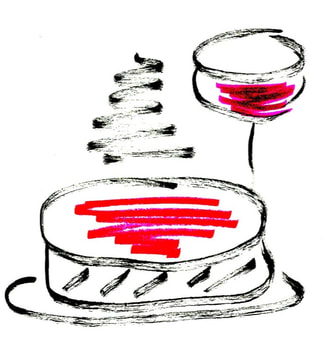 Consider an earthy Merlot from the Walla Walla Valley wine region to pair with a tomato soup. Consider an earthy Merlot from the Walla Walla Valley wine region to pair with a tomato soup. For a steaming bowl of tomato soup, do you go with an earthy Merlot from the Walla Walla Valley wine region to make the most of the tomatoes’ savory dirt elements? If the tomato soup is, in fact, a chilled gazpacho, would you instead reach for a fruity Godello to play nicely with the acidic elements of the soup? When grilling lamb chops for your main course, you could reach for the dark plum and fig fruit flavors of a Bobal from the Utiel-Requena wine region of Valencia in Spain to offset the lamb’s gamey, ashy flavors. For a more earthy, brooding wine to accompany the grilled lamb, drink a Sagrantino di Montefalco for the black fruit, licorice and pine tar that it brings to the table. For a cheese course, do you want a fruity and versatile Chenin Blanc or a more savory yet equally versatile Roussanne? As the captain of your drinking ship, you can have fun alternating between fruity and earthy wines, even within the same course, and explore the differences. Earthy wines have aromas and flavors evocative of the earth and often have savory characteristics. You might get mushrooms, vegetation, soil, wet leaves, rocks, game, minerals, leather, or tobacco from these wines. Time in oak, wine aged sur lie (kept in contact with spent yeast cells), bottle aging, oxidation, fermentation practices and environments, and other factors affect the perceived earthiness of a wine. The vineyard’s terroir has a tremendous impact on a wine’s earthiness. For instance, red wines produced from iron-rich clay soils sometimes deliver a mild yet surprisingly pleasant bloody note. If you pick up smokey or ashy elements from a wine, you might be right to suspect that the grapes were grown in volcanic soils. The use of wild yeast, commercial yeast, or a combination of both during fermentation also inform a wine’s earthy qualities. Biodynamic, organic and natural winemakers promote a minimalist approach to winemaking, and many opt to use the wild yeast that naturally occurs in the vineyard and cellar environments rather than rely on a commercial laboratory to supply yeast that has been propagated to produce a reliable outcome. Natural winemakers, as well as traditional winemakers who use natural yeast, claim that their use of indigenous (wild) yeast promotes a more complex flavor profile. These winemakers know they are taking a chance that the environment will also provide unwanted spoilage bacteria, so sanitation becomes even more important than usual. Winemakers who rely entirely on natural yeast can choose to mitigate their risk by adding a small amount of sulfites to kill harmful bacteria and to stabilize the wine. If you are a winemaker who elects to use commercial yeast, you are in the composer’s seat, choosing from a library of offerings with qualities that go well beyond earthy or fruity. Several of my friends allow the natural yeast to do their work for a day or two, then add commercial yeast to clean up any possible undesirable bad actors that could ruin the beverage. Yeast is highly complex and fascinating and scientists admit they do not fully understand everything that is happening during the fermentation process. As a homebrewer, I enjoy playing with various approaches, whether it is going completely natural, mixing a combination of commercial yeasts, or starting wild then tempering the fermentation with commercial yeast. If I had shareholders to please, my choices would be much more restricted. Additional factors affect a wine’s earthiness. Grapes grown in cooler climates such as Burgundy, France and Italy’s Trentino-Alto Adige do not achieve the sugar levels enjoyed in warm climates with intense sunshine such as California’s Sacramento Valley and Argentina’s Mendoza Province. Cool-region wines tend to be less fruity, revealing more earthy notes in their flavor profiles. A grape’s ripeness level has a tremendous influence on earthy vs. fruity aromas and flavors. Fully ripe grapes are prone to display fruity characteristics while under-ripe grapes are inclined to offer herbal or vegetal attributes. 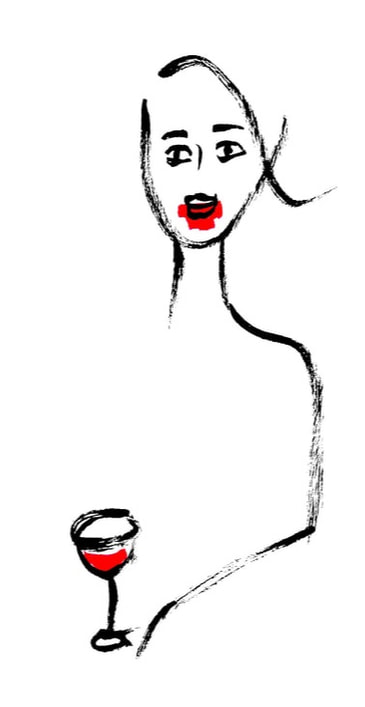 Red wines produced from iron-rich clay soils can deliver a mild yet surprisingly pleasant bloody note. Red wines produced from iron-rich clay soils can deliver a mild yet surprisingly pleasant bloody note. A quality wine can be fruity or savory, and many wines share elements of both. For instance, a Grüner Veltliner from the Wachau region of Austria has citrus and/or stone fruit characteristics that are typically accompanied by the earthy and savory notes of white pepper (and perhaps toast, in those that are aged). Sometimes a wine is aged beyond its prime and displays little to no fruit characteristics. This is considered a flaw because what remains is a mere flavor shadow compared to the wine at its peak. Fruity wines showcase fruit aromas and flavors over and above other aspects. A lot of people associate a fruit-forward wine with sweetness, but many fruity wines actually finish dry. The next time you perceive what you think is sweetness, ask yourself if you are in fact detecting fruit flavors rather than sugar. To distinguish one from the other, pay close attention to the finish of the wine. A wine that finishes dry, even if you experience delightfully bright red fruit such as raspberries and cherries, is considered to be a dry wine. Some winemakers go to great lengths to preserve the fresh fruit purity of their wine by fermenting and aging the wine in stainless steel, concrete or other air-tight vessels instead of oak. This is because oak allows in small amounts of oxygen to change the nature of the finished wine to include non-fruity elements. A lot of people associate a fruit-forward wine with sweetness, but many fruity wines actually finish dry. The next time you perceive what you think is sweetness, ask yourself if you are in fact detecting fruit flavors rather than sugar. To distinguish one from the other, pay close attention to the finish of the wine. Fruitiness is often associated with New World wines (North and South America, Australia and New Zealand, South Africa, etc.). Earthiness is more associated with Old World wines (France, Italy, Germany, Spain, Portugal, etc.). There are many exceptions to this line of thinking, especially as winemakers travel the world to experience wine in other countries and share ideas and technical information. The drinking public also helps shape how wines are made. Styles go in and out of popularity and many winemakers accommodate what is fashionable or risk losing sales. For instance, the majority of buyers today ask for a dry rosé, so producers all around the world create offerings typical of the crisp, pale-colored, light-bodied, dry style of the Côtes de Provence rosés of Southern France. In the past, sweet rosés were all the rage. Drinkers who are new to wine often prefer fruity styles. As their palates mature, these drinkers begin to appreciate the complexity and intrigue of savory elements in the beverage. Oh, for heaven’s sake, rain is suddenly coming down hard. What, is that hail pounding on my skylight? I guess the pasta dinner will be made tonight. Can’t say I’m sorry about that, because now I can rummage through my farmers market finds to create a meal for Peter that will be just right for that Cerasuolo. Soon I will put away the “pen” and enjoy the warmth of a hot stove. I will create a meal that will be the perfect finish to a day that engaged my body with a good run, my mind with this conversation, and my senses with excellent wine. Here’s a toast to being flexible without giving up on what matters in life: good food, good wine, good health and, especially, good company. Earthy Varieties Whites: Sauvignon Blanc Chardonnay (Chablis) Garganega (Soave and Gambellara) Grüner Veltliner Roussanne Savagnin Silvaner/Sylvaner Vermentino Reds: Aglianico Cabernet Franc Cabernet Sauvignon Carménère Corvina Fumin Grenache Malbec Mencía Merlot Mondeuse Noire Mourvèdre/Mataro/Monastrell Nebbiolo Nero d’Avola Piedirosso Pinotage Pinot Noir Poulsard/Ploussard Sagrantino Sangiovese (Chianti Classico) Syrah/Shiraz Tempranillo Trousseau/Bastardo Fruity Varieties Whites: Albariño Chardonnay Chenin Blanc Friulano Gewürztraminer Godello Malvasia Bianca Marsanne Moscato Riesling Torrontés Viognier Reds: Bobal Cornalin Frappato Gamay Garnacha/Grenache Nerello Mascalese Pinot Noir Plavina Schiava St. Laurent Teroldego Valdiguié Zweigelt This is one in a series of Grape Detective blogs featuring the attributes of wine and how your love for a specific wine grape may lead you to discover new grapes with similar characteristics. The focus of the list is grape variety and does not include blends, wine regions, or styles.
0 Comments
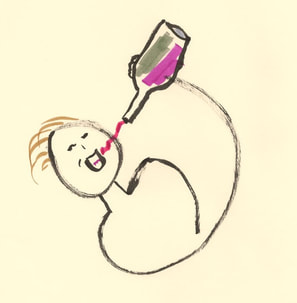 Garnacha is the one I would pour all over my face, in the town square, under the spotlight of the sun. Garnacha is the one I would pour all over my face, in the town square, under the spotlight of the sun. Have you ever met someone who causes you to lose all forms of self-control? For me, lusty Garnacha is the one I would pour all over my face, in the town square, under the spotlight of the sun. It would be reckless. Certainly illegal. It would be humiliating. And I would love every drop of that ruby red wine streaming out of the bottle and into my mouth. Onlooker shock would turn to bemusement at this shameless display of public affection. Intense relationships start hot, igniting the pleasure center in our brains, and Garnacha had me at hello. The origin of my intrigue with Garnacha lands squarely on the shoulders of Monica M., a key educator in my formal wine training and subsequent certifications. When wine classes are taught by a Spaniard, you quickly become curious about the wines of Spain and their many incarnations. I rummaged through the aisles of The Wine House in Los Angeles and picked up a bottle from Priorat, a hotbed of winemaking creativity and excellence in northeastern Spain. The bottle was a 2014 Mas Doix Les Crestes Priorat with a distinctive label featuring a rooster sporting a large red cockscomb. The wine was eighty percent Garnacha from twenty-year-old grapevines blended with ten percent old vine Carignan grapes and ten percent Syrah. Once home, I uncorked the bottle and just like that naughty Garnacha stole my heart. Red cherry, cranberry, strawberry, licorice and cinnamon aromas clouded my vision. I thanked my lucky stars for the pleasure that Garnacha gave me without reserve. But my conscience does not allow me to end the sweet memoir here. You, my friend, deserve more than a steamy love story. As with many affairs, there is a cautionary tale involved. While flooding your nose and mouth with spicy, red fruit flavors and aromas, Garnacha hides a dagger behind her back in the form of high alcohol. Garnacha’s alcohol by volume ranges from thirteen point five to sixteen percent; fifteen percent is very common. So you see, you will never be able to love her with the complete abandon she accords you. Tragically, Garnacha will always be the superior lover in this relationship, so keep your dignity, if you can, by girding your loins against the mischievous alcohol that is skillfully concealed by the best makers. The Mas Doix I drank that day, for example, was fourteen-point-five percent ABV. It is this very attribute of high alcohol, along with a full body, that attracted Burgundian winemakers in the seventeenth century to add her to their Pinot Noirs to make them more interesting. Experienced lovers have mysterious pasts, and Garnacha is no exception. There has been a tug-of-war among wine lovers about the origin of this grape. Some feel that Garnacha originated in Aragon in northern Spain. Others insist she was born in Sardinia. Like many, I am inclined to believe that she is of Aragon because this area has the widest range of Garnacha varieties (red, white, grey, Peluda). More importantly, Garnacha’s clonal diversity in Aragon eclipses that of Sardinia. Garnacha’s parents are unknown. She holds tight to her secrets.  She is an avid sunbather, even though she is thin-skinned, and she tolerates drought conditions with aplomb. She is an avid sunbather, even though she is thin-skinned, and she tolerates drought conditions with aplomb. The only way to know enigmatic Garnacha is to experience her attributes in the here and now. Garnacha has many hot spots of production, literally, as she prefers a warm or hot climate. She is an avid sunbather, even though she is thin-skinned, and she tolerates drought conditions with aplomb. In no hurry to impress, Garnacha is a late ripening grape; she takes her time. Pick her grapes too early and she cannot reach her peak of perfection. Her generous body is there strictly for your pleasure. Most famously, she is the key grape in the Southern Rhône’s Châteauneuf-du-Pape wines, where she is known fondly by her friends as Grenache. Châteauneuf wines showcase delicious Grenache, often with the blending partners of Syrah and Mourvèdre, to create full-bodied wines of spicy, concentrated red and black fruit. In vintages with hotter climates, Grenache can get overly jammy, so her blending partners help balance the final wine with tannins, color, acidity, and layered flavors. In some cases, such as Château Rayas, the very finest Châteauneuf is composed of one-hundred percent Grenache in lieu of using any of the thirteen permitted grape varieties for producing red Châteauneuf. An older vintage from Rayas can put you back two-thousand dollars for a single bottle. How does Château Rayas manage to produce what may be the Southern Rhône’s finest wines without the help of blending partners to correct her soft tannins and low acidity? For one thing, Rayas, located in the northeastern area of Châteauneuf-du-Pape, enjoys the coolest microclimate in the Southern Rhône, so the grapes are unlikely to be over-baked and flabby. Trees and forests exert a cooling influence on the soil. These advantages result in naturally lower yields and longer hang time for the grapes, turning up the dial on flavor intensity. With less heat, the grapes at Rayas preserve their precious acidity. Grapevines, under these conditions, grow at a pace conducive to tannin concentration. The terroir at Château Rayas makes it possible to harvest the grapes later in the season, at their perfect level of ripeness, without driving up the sugar level. The result: fresh, pure, silky wines that are lower in alcohol than those of many counterparts. In short, this wine is the very essence of elegance. The Dutch Golden Age painter Johannes Vermeer would have watered at the mouth to paint this Grenache beauty, a real pearl of a wine. Grenache is the most planted variety in the Southern Rhône. About half of the Southern Rhône’s wine production is labeled simply as Côtes du Rhône, and these are fruity, simple, medium-bodied red, white or rosé wines meant for casual consumption. If you thirst to investigate wines of a more serious nature, you can trade up to offerings that fall under the Côtes du Rhône Villages appellation. These wines have strict laws that address alcohol levels, permitted yields, and wine grape composition, along with other aspects of winemaking. The very best wines are cru wines, such as the Château Rayas from Châteauneuf that we discussed. A cru is a legally distinct region that is recognized for its quality and unique terroir. In Châteauneuf, many growers claim their vines are over one hundred years old. This age on Grenache contributes greatly to building a wine with deep flavors. Southern Rhône crus include Châteauneuf-du-Pape (the original cru of the Southern Rhône), Tavel and Lirac (best known for their Grenache-based rosés), Gigondas, Rasteau, Beaumes de Venise, Vacqueyras, Cairanne, and Vinsobres. By the way, Gigondas, located just ten miles away from Châteauneuf, provides a similar style of wine at a much lower price point. The wine there is getting so good that even experts may not be able to distinguish it from a Châteauneuf wine, but you will know the difference, expert or not, at the cash register. If you were standing in the middle of a typical vineyard in the Southern Rhône, you would find Grenache’s vines to be bush-trained, clinging low to the ground. This helps her withstand the area’s powerful north winds, known as the mistral. As you stood in the vineyard taking in the songs of the birds and thinking that life is good, you would marvel at the bounty of large stones covering the vineyard’s soil. The stones, known as galets, evoke a moon-like appearance. Why are they there? They absorb the sun’s rays during the day and warm the vineyards through the night. Go ahead . . . crouch down . . . touch the stones . . . and feel the warmth. This is old-school technology at its best, creating ripening conditions for our lovely growing girl. Grenache is also found in France’s Languedoc-Roussillon wine region, where she courts several blending partners such as Syrah, Mourvèdre, Carignan and Cinsault. 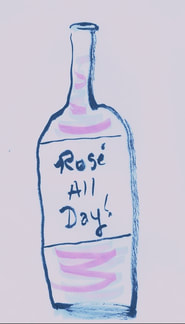 Grenache is one of the dominant varietals used in making the Provence rosé blends that are so hot right now. Grenache is one of the dominant varietals used in making the Provence rosé blends that are so hot right now. Grenache is one of the dominant varietals used in making the Provence rosé blends that are so hot right now. Her thin skin produces less color than, for example, a thick-skinned cabernet sauvignon grape that is rich in coloring matter. Lack of color makes Grenache an ideal blending grape for the production of the pale rosés that consumers fancy. I recognize Grenache anytime I taste her in a blend, especially in a rosé. As waves of wine roll around my tongue, it is as though Grenache’s blending partners evaporate, leaving her completely exposed, and (guess what?!) she doesn’t care. Grenache flaunts her flavors like nobody’s business. Back in Spain’s increasingly acclaimed Priorat wine region, classic blends are composed of old vine Garnacha and Carignan (known as Cariñena in Spain). The very best examples from this region are full-bodied and minerally, with flavors that might include a complex weave of brandied cherries, tar and licorice. These wines command some of the highest prices in the world. Priorat’s vineyards are hot and dry, much to Garnacha’s delight. Old grapevines struggle in nutrient-poor soils to produce very low yields and mouth-watering flavors. In the Rioja wine region of Spain, Garnacha contributes body, alcohol, and heady flavors and aromas to Tempranillo, the dominant variety there. While the neighboring Rioja and Navarra regions focus on Tempranillo-based wines, the Calatayud and Cariñena wine regions of Spain claim Garnacha as their most favored grape. Sardinia is a real player in the world of Garnacha, and on this island she is known as Cannonau. The Cannonau di Sardegna appellation covers the entire island. Many feel that the best examples are found on the eastern side. Italian scientists have unearthed information suggesting that Cannonau originated in Sardinia, not Aragon, so the ongoing tug-of-war over Garnacha’s birthplace will continue until indisputable proof surfaces. From time to time, my clients ask me to recommend a wine for medicinal or health purposes. Personally, I love this because it makes me feel like Doctor Lyne, though it is beyond my pay grade. In these cases, I sometimes call upon Cannonau’s restorative powers. Buyers get excited when they learn that Sardinian locals have extraordinarily long lifespans. We are talking about people who live into their nineties or to over one hundred years old. Some attribute this longevity to the Sardinian diet, including the wine. Cannonau is high in anthocyanins and polyphenols, antioxidant compounds that are thought to contribute to heart health. Who am I to challenge this thinking? The Sardinians are doing something right. You will also find Garnacha south of Sardinia on the island of Sicily, where the locals call it Alicante. Garnacha is a jet-setter, growing well in Australia’s Barossa Valley and McLaren Vale, and you will spot her on California’s Central Coast as well as South Africa and Israel.  Garnacha Peluda is a variant of red Garnacha with the underside of the leaves displaying a peculiar hairy appearance, almost as though she forgot to shave her armpits. Garnacha Peluda is a variant of red Garnacha with the underside of the leaves displaying a peculiar hairy appearance, almost as though she forgot to shave her armpits. Garnacha expresses herself in varieties beyond the ruby red, known in Spain as Garnacha Tinta and in France as Grenache Noir. Garnacha Blanca, the white wine grape, is being produced as a one hundred percent varietal with a golden hue and a full body in Priorat and other Garnacha-centric Spanish wine regions. Look for characteristics that include floral notes, citrus, and ripe stone fruit accented with pinches of rosemary and thyme. Throughout the south of France, Grenache Blanc is produced as an easy drinker with low acidity and high alcohol, often presented with its traditional blending partner, Maccabéo. Châteauneuf-du-Pape produces white offerings, Grenache Blanc among them, that are weighty and intensely aromatic. You will also find Grenache Blanc on California’s Central Coast, especially San Luis Obispo. Garnacha comes in classic gray as well but it has limited worldwide production. Look for it in the south of France, where it goes by the name of Grenache Gris. This wine exudes apricot and stone fruit aromas and some examples have a satisfying, oily mouthfeel. It is a bit of an obscure wine but that in itself is interesting for those of us who are always on the lookout for something new. There is some production of this grape in Spain, South Africa and California. Grenache Gris is genetically one and the same as Grenache Noir and Grenache Blanc but simply has a pinkish-gray skin. Even though this grape is relatively rare, many feel that she is blessed with a more profound flavor than her white sister. Now we get to the hairy proposition of Garnacha Peluda. This is a variant of red Garnacha with the underside of the leaves displaying a peculiar hairy appearance, almost as though she forgot to shave her armpits. Clearly, this is the more earthy side of Garnacha. Peluda is planted throughout Spain and in southern France and has a lower alcohol content than traditional Garnacha. It is not unusual to find red Garnacha and Peluda in the same vineyards and they are often mixed together in fermentation and/or blending. What should you eat while drinking red Garnacha? The good news is that Garnacha is one of the world’s most versatile wines for pairing with food, mostly due to her pure red fruitiness, hint of citrus and other refreshing qualities. Her wide range of depths and textures, along with a kick of spice, are ideal with braised, grilled or stewed meats such as chicken, veal, lamb, beef, game and pork. Garnacha also pairs nicely with salmon and trout, especially when grilled. Match Garnacha’s spiciness with Indian food, though I would steer clear of very highly spiced food of any kind as wines that are high in alcohol make hot, spicy food taste even hotter. If you are not in the mood for meat, call on Garnacha for pairing with a mac and cheese dinner or a lentil- or bean-based dish. For white or gray Garnacha, as well as rosés, seafood is a natural. Think about fish tacos, crab cakes and garlic prawns. If you have read my blog post on food and wine pairings, you know that choosing wines that match the origin of the food is one way to start getting creative with your dinner planning. It is no surprise, then, that all colors of Garnacha pair well with the quintessential Spanish dishes of charcuterie and paella. Some winemakers harness Garnacha’s naturally high levels of alcohol and sugar to produce a fortified dessert wine known as Vin Doux Naturel. Drink this style on its own or pair it with dark chocolate, caramels, brownies, and cookies. These desserts also pair well with most other styles of Garnacha. If you are planning a cheese course with Vin Doux Naturel wine, you can reach for Brie, blue cheese, Cheddar, Gouda, Gruyère, and Manchego. I’ll let you in on a little secret: Spanish wines are among the best values available on the market. Many of the wines you already enjoy share some of the same characteristics found in red Garnacha and you may be able to pay less for the same quality by switching. If you get weak at the knees for Syrah, Amarone, Mourvèdre, Tempranillo, or even Merlot, consider a tryst with Garnacha. There, I’ve gone and done it again. This story is longer than most because I have, once more, lost all control when it comes to Garnacha. If you find yourself falling in love with her, it hurts me to tell you that you will be one of a long line of lovers. The awful truth may bruise your ego, but you will, in time, learn to accept Garnacha as she is and without complaint. In fact, the only way to upset her is to ignore her on the third of September, International Grenache Day. But you won’t do that because you want to have her around all the time. A bad day with Garnacha is better than a good day with anyone else, even if she leaves you crying on the street and making a public spectacle of yourself, yet again. Take my advice and resolve yourself to the fact that Garnacha is a woman you can’t forget . . . and that you will never leave. Garnacha: General Characteristics Flavors: cherry, raspberry, blackberry, candied fruit roll-up, cinnamon, white pepper, citrus skin, licorice, tobacco, oregano, lavender Acidity: low to medium Tannins: low to medium Texture: soft tannins Alcohol: high Body: medium- to full-bodied Key regions: Spain: Priorat, Rioja, Calatayud, Cariñena, Navarra, Montsant; Italy: Sardinia, Sicily; France: Southern Rhône, Châteauneuf-du-Pape, Languedoc-Roussillon, Gigondas; Australia: Barossa Valley, McLaren Vale; United States: California’s Central Coast Parents: unknown Origin: most likely Aragon in Northern Spain; possibly Sardinia Also known as: Grenache, Grenache Noir, Garnacha Tinta, Garnatxa, Cannonau, Cannonau di Sardegna, Lledoner, Tinto Aragones, Alicante, Granaccio 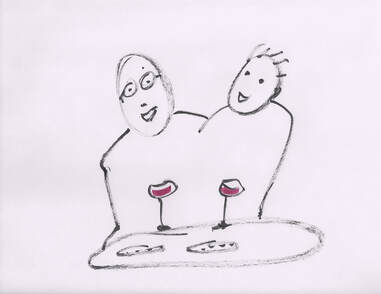 Your food and wines gain body and strength in lockstep with the conversation. Your food and wines gain body and strength in lockstep with the conversation. Choosing the right wine to go with your dinner is easy when you use these tips. However, food and wine pairing is more than just following tried-and-true rules created by chefs and sommeliers. Pairings provide you with an opportunity to get creative and treat your guests to a special evening, even if it is just a casual get-together. Think about it: as you plan the dinner, are you more concerned with orchestrating a great experience or with making technically correct wine choices? For most people, connecting with friends is at the top of the list. So relax when choosing your wines, this is not a contest. You can always open a different bottle if your initial choice does not hit the spot. The master plan is to pair your wine not only with the cuisine but with the ebb and flow of social interaction. Tell me, what usually happens when you have a couple over for dinner? When they knock on the door, do you invite them in and start with small talk? Maybe you ask about their day or you compare notes on how your favorite sports teams are performing. How might that equate with the wine you are serving? Perhaps you will pour a sparkling wine, such as a Prosecco, something low in alcohol and light and frothy, like the conversation. When you sit down to dinner, after you and your guests have loosened up a bit, you move on to a first course, such as a summer soup or a salad, and serve a white wine or rosé. As the courses progress, you find yourselves in conversation that has graduated to deeper, more meaningful topics. Your food and wines, too, can gain in body and strength in lockstep with the meal and dialogue. The idea is to pour your wine in progression with the overall experience of the diners. Start with light-bodied wines and graduate to heavier wines. Pour low-alcohol wines first, then amp up the experience with higher alcohol wines to match the heavier courses. Now that we are armed with the big picture, let’s get to the food and wine pairing tips, as promised. Choose wines that match the origin of the food. When I am asked to recommend a wine to go with a particular dish, my first inclination is to consider the origin of what is on the plate. In other words, is the dish associated with the cuisine of a particular country or region? If so, I take a mental trip to that location and consider the local wines on offer. For instance, if you plan to serve a pasta with red sauce, go right to Italy for the wine, perhaps selecting a Chianti Classico or a Brunello di Montalcino. When serving old-school American hamburgers from the grill, why not reach for a Zinfandel from California’s Sierra Foothills. You might instead elect to put some bratwurst on the grill and couch the sausages in soft buttery buns. In that case, you could go for a semi-sweet Riesling from the Pfalz, Germany’s second-largest wine region. You get the idea: eat and drink like a local. Match the intensity of the wine with that of the food. You probably have a pretty good feel for the intensity of the dish you plan to serve. For instance, you know that salads and seafood are generally less intense than barbecue ribs and ribeye steaks. When we talk about the intensity of a dish, we are usually thinking about the amount of fat and/or the boldness of the flavor. Salads and seafood are typically light in fat and delicate in flavor. These types of dishes call for wines with a light body and subtle flavors. Light bodied wines typically are low in alcohol, less than thirteen percent alcohol by volume. Wines to consider with light fare include Pinot Grigio, Prosecco and Vinho Verde. The ribs, with their bold barbecue sauce, and the ribeye steaks, with their juicy fat, call for wines that are equally bold in flavor and body. While proteins abound in main meals, it is often the sauce you put on them that will be the pointer to selecting wines with complementary flavors and intensity. For your ribs, the highly intense barbecue sauce will point you to a bold Zinfandel, Syrah/Shiraz, or Malbec as all these wines have strong flavor profiles and are full-bodied. Full-bodied wines present at around fourteen percent ABV or higher. The fats in your ribeye steak are responsible for delivering the juicy tenderness you crave. These same fats soften the tannins in wine and elevate tastiness, so look for red wines with medium to high tannins to go with those fatty red meat dishes such as Cabernet Sauvignon, Nebbiolo and Sangiovese. Match the key flavors of the food and the wine. We were talking about a red pasta sauce a moment ago. Some wines, such as Merlot, Cabernet Sauvignon and Carménère can exude the herbaceous aromas of tomato leaf, so you would be spot on to call on these wines to unlock the flavors of the tomato sauce in your mouth. Salads and other foods with citrus dressings or sauces offer a clear invitation to match wines with aromas and tastes of lemons or limes such as Sauvignon Blanc or a Vermentino or an Albariño. If you are serving cranberry sauce on your Thanksgiving turkey, Pinot Noir from Oregon, with its vibrant acidity and cranberry aromas, is a classic match. For a dessert that is dotted with kiwi fruit, a Chenin Blanc from Saumur in the Loire Valley of France might offer up a similar aroma. If you cook up a beef stroganoff with mushrooms, your nose may catch mushroom aromas from mature Pinot Noirs, Nebbiolo wines, or Spanish Rioja wines. 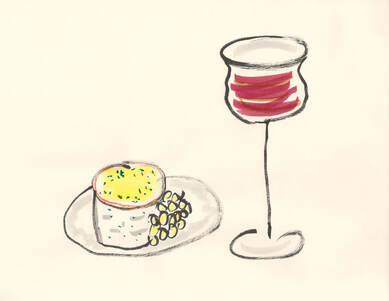 Port wine envelops Stilton cheese in a bath of blackberry and chocolate flavors. Port wine envelops Stilton cheese in a bath of blackberry and chocolate flavors. Layer the experience with contrasting flavors. Contrasting but complementary flavors in your food and wine create entirely new taste sensations. An example of this is to pair fish and chips with a fresh and lively white wine. In this case, I might reach for a Verdicchio from Italy’s Marche region. Not only is this wine considered one of Italy’s best whites, it has the lively acidity to cut through the grease of what’s on the plate, refreshing your mouth for the next bite. If you are serving a salty Stilton cheese, a classic and satisfying contrast is a weighty, sweet Port wine. The Port’s body will envelop the semi-soft Stilton in a luxurious bath of blackberry and chocolate flavors. The two together are a perfect marriage of sweet and salty flavors. Is your mouth watering yet? Another sweet and salty pairing would start with crispy udon noodles with nori salt on the plate. The answer: Champagne’s sparkling wine to complement the salty fare with its light kiss of sweetness. Take the acidity of the food into account. Meals that sing with bright acidity are a natural companion to light, refreshing wines that are also high in acidity or tartness. Examples of foods with zesty acidity go beyond salads or whitefish topped with a squeeze of lemon. Balsamic chicken, any meal with pickled veggies, potato salads, balsamic glazed lamb, and food topped with chutney are all acidic in nature. When we talk about a wine’s acidity, we are describing that tart, sour taste you get in your mouth, like you would get from adding a twist of lime to your Mezcal or to a taco before you pop it into your mouth. Your first thought might be light-bodied, tart white wines such as Sauvignon Blanc, Vermentino or Albariño. However, exciting acidity can also be found in rosés from the Provence wine region of France, Pinot Noirs, Champagne and other sparkling wines, Beaujolais wines, and many others.  You want light-bodied, fresh and crisp wines to tame the spice. You want light-bodied, fresh and crisp wines to tame the spice. Take a special approach to pairing wine with spicy foods. There are a couple of ways to deal with spicy food when it comes to wine: either choose wines that complement the flavors of your spicy dish, or tame the heat with some sweetness and/or fruitiness. If you have a peppery dish, you can count on a juicy Shiraz blend from Australia to provide pepper notes while washing over the spices with jammy goodness. In this pairing, you are both complementing the peppery flavors and taming the heat with fruitiness. Another wine that could offer a fruity blanket over the spices in your dish would be a Beaujolais from just south of the Burgundy region of France. In general, you want light-bodied, fresh and crisp red or white wines to tame the spice. We are talking Pinot Grigio, Albariño, Riesling, a New Zealand Pinot Noir, and Sauvignon Blanc. Slightly sweet wines, such as off-dry Rieslings and Gewürztraminers, offer a pleasing contrast and provide a balance to the spice. Avoid wines that are high in alcohol or risk making your hot, spicy food taste even hotter. When cooking up a spicy dinner, I typically reach for a bottle with about twelve percent alcohol by volume. Pair desserts with sweet wines. Asti is a sweet sparkling wine from Italy that dances beautifully on the tongue with custards and other creamy desserts, scrubbing away the buttery fat with refreshing bubbles while going toe-to-toe on sweetness. A late-harvest Gewürztraminer is delicious with cinnamon-infused apple pies, both sharing not only the element of sweetness but also spiciness. For rich dark chocolate desserts, Port wine is a classic match. But you don’t have to stop there. Zinfandel, Syrah/Shiraz, and Sherry are willing mates for chocolate. Milk chocolate lovers might reach for Merlot or a Pinot Noir. A Cream Sherry might be just the ticket for a white chocolate dessert. Most high quality dessert wines are balanced by high acidity and taste quite fresh. These are not wines that will tire your palate with cloying sweetness. A quality sweet wine, such as an Icewine from Canada’s Niagara Peninsula or a Sauternes from France’s Bordeaux region, can be your dessert course, with or without food. In general, sweet wines are a natural match for spicy, salty, and sweet dishes. Remember, this is not rocket science. Don’t get too wrapped up in getting your pairings just right. We all make mistakes until we’ve practiced a bit. Like learning to ride a bicycle, matching the right wine with a plate of food feels a bit clumsy at first until you get the hang of it. Most of all, let your palate weigh in when you experience the food and wine together. Pairing food with wine boils down to matching the mood of the situation, the cuisine on offer, the company, the location, practical circumstances, budget, personal preferences, and so much more. You can paint your pairing situation with broad strokes, going with tried-and-true rules. You can go granular, matching your wine with the food’s country, wine region, cultural mores, and the mood of the get-together. Or you can fly high, with all your chips on the table, and experiment with food and wine combinations that nobody told you about. It is all good, and it is all part of your development as an aficionado of food and wine. This article is partially excerpted from my new book, Your Love Affair with Wine: How to Meet and Fall in Love with a Bottle of Wine, available on Amazon  Should a wine list the size of a bible drop into your hands, don't break into a cold sweat. Should a wine list the size of a bible drop into your hands, don't break into a cold sweat. Does the thought of ordering wine at a restaurant make you nervous? The bigger the wine list, the easier it is to feel intimidated by the number of choices, the staggering prices and the embarrassment of “getting it wrong.” For this reason, many people pass the list over to the person at the table who is the most willing to take on the daunting challenge or perceived to be a wine connoisseur. Should a list the size of a bible drop into your hands, don’t break into a cold sweat. At best, this is your opportunity to explore beautiful choices from wine regions around the world. Your pulse will be racing not from the fear blooming in your chest but from the excitement of choosing from a tasty lineup of Pinot Grigios or Merlots, for instance. Taking command of the situation also saves you from enduring someone else’s dull choice of an overpriced label available at the supermarket around the corner. After all, dinner out should present you with new culinary and beverage experiences, not the same old safe choices. While ordering wine at a restaurant may seem fraught with obstacles and wrong turns, it is also an opportunity to personally grow in your understanding of wine and have fun doing it. No, do not fret, dear wine lover. Instead, embrace these tips to order wine like a boss and up your game with increasingly savvy selections at any restaurant, anywhere. Take your time. As you look through a restaurant’s wine list, it is all too common to feel pressured into making a quick choice as the server taps her foot expectantly, waiting for your order and your thirsty dinner companions look on with anticipation. The more you know about wine, the more your companions will expect you to dazzle them with something unique and first rate. If you pick too quickly, however, you may miss finding a bottle that would be the night’s star. At worst, you may be told that the bottle you selected is unavailable and find yourself paying twice the price for a poor substitute, much to the chagrin of those also paying. So here’s how we are going to get started. On your next date night, keep in mind that making the wine selection is not a race. In fact, take all the time you want. You’re in charge here. You own the room. Breathe in and relax as though you are in your own living room, but please be sure to wear your pants and not just underwear. Don’t forget your shoes. Don’t worry about the size of the list. For sure, a small wine list is comfortable, especially if the labels have been thoughtfully selected. In the case of a small list, I look for unusual offerings and place my order posthaste. Maybe it is a wine grape I have never heard of or a producer that piques my interest. Some people just look for the second least expensive glass or bottle on the list and place an order. A large wine list can be initially alarming, but it also means you are likely to find gems at a price point that suits your budget. Start with a bubbly. If you fear you will crack under the pressure of having to make a timely decision, order a fun, inexpensive sparkling wine by the glass for you and your drinking partner right away. Something like a Cava from Spain or a Prosecco from Italy. Sparkling wine is a merry way to start a meal and it lends an air of celebration. Life is good when you can celebrate, even if it is on a Monday night. While drinking the bubbly, ask your partner about what he would like to drink so you can factor in his preferences. Approach a huge list like you would a coffee table book. Don’t you just love coffee table books? Instead of big pictures, you are looking at big countries. Big deal. You’re a citizen of the world. If you need reading glasses, put them on now. Please don’t be that person who uses a phone flashlight to read the list; it is distracting to others. If the room is too dark for reading, ask the server to put a candle on the table or leave the room to find better lighting. Review the wine list and see what’s on offer as you sip your bubbly. So far as everybody in the restaurant knows, you do this every night of the week. Pair your wine selections with the food. Traditional food and wine pairing guidelines will help you get some ideas going. Highlights of pairing include selecting food and wines from the same geographic area. A Chianti Classico is a good match for pasta dishes with red sauce from central Italy. You can also match key flavors in your food and wine. Salads with citrus dressings offer a clear invitation to match wines with aromas of lemons or limes such as a Sauvignon Blanc from New Zealand. Bring together contrasting but complementary flavors. Carne asada tacos can be paired with a light-bodied, crisp German Riesling to create an entirely new taste sensation. Pair acidic or spicy food with light-bodied, fresh and crisp whites or reds. Match the intensity of the dish and the beverage. When we talk about the intensity of a dish, we are usually thinking about the amount of fat and/or boldness of flavor. For instance, ribeye steaks, with their juicy fat, can be paired with a Nebbiolo or a Cabernet Sauvignon. If you are unsure about how to pair your wine with the food, do a quick internet search on your phone such as “wine pairings for salad with balsamic vinegar dressing or wine pairings for steak au poivre." Consider a few candidates. Do you want a red, a white or a rosé? Another sparkling wine? The list will likely be organized by region, grape variety or by wine characteristics. Take a mental trip through the list, noting prices. After you have calmed down and spotted two or three choices that look promising, do one of two things: pick one and place your order, or ask for a second opinion from the server. My vote: second opinion, unless you come to realize during the conversation that you know more about wine than he does. When speaking with the sommelier or server, point to two or three wines that have caught your attention. This helps the somm understand your desired flavor profile and, just as importantly, the price range that is in your comfort zone. A good somm will know about the hidden treasures on the list. Go for what is suggested, unless the price is above the price range you have indicated. And don’t be afraid to ask questions. Nobody knows everything about wine and you will learn much more quickly if you ask questions and keep an open mind. Even wine “experts” tend to specialize in certain wine regions because it is impossible to know it all. That’s the charm of wine: it is a lifelong learning experience. Should you go by the glass or invest in a bottle? That is up to you. Generally, you will pay more by the glass if you have more than two or three glasses. However, it can be a lot of fun to have a new glass of wine with each course and this approach allows for more exploration. When ordering by the glass, some restaurants allow you to select small, medium or large pours, usually described in ounces. I love this option because I can order the smallest pours of multiple wines to experience a number of varieties, makers, wine regions, and winemaking techniques. One downside of ordering by the glass: once a bottle is opened, the wine begins to spoil. Some opened bottles sit for several days before being poured out. If your wine tastes off, ask the server for a second opinion. She will likely open a fresh bottle for your pour. 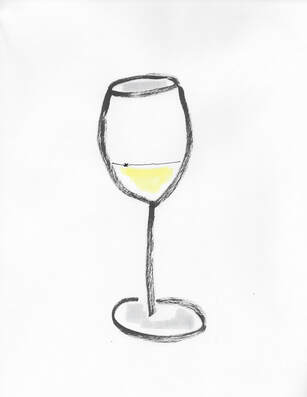 The server "helpfully" pointed out the bug in my Chenin Blanc. The server "helpfully" pointed out the bug in my Chenin Blanc. Stay alert: not all advice is good advice. As you know, there are good advisors and there are bad advisors, in life and in wine. Most of the advisors you will encounter are good to great. A bad advisor will suggest wines that are well above the price point you have indicated. In that case, go with one of your original choices. Watch out too for the bait-and-switch. “Oh, we don’t have the wine in stock, can I bring you out a blah-blah-blah?” In answer, ask to see the substitute on the wine list so you can furtively review the price before you agree. Bad advisors thrive in venues that count on tourists. I had a server in such a place tell me that there was a bug in my glass of Chenin Blanc; he offered to help. “How nice is that?” I said to my guest as we enjoyed our seafood dishes on the patio. The server brought out an empty glass, then picked up the bottle from the table and poured. He then added wine to the original glass with the bug in it and took it away for his own consumption, much to our surprise. I suppose that was a bug and switch. The location was New Orleans, a town that I treasure and visit each year. But you never know. The same server had earlier suggested an eighty dollar wine bottle when the original forty dollar bottle I requested was out of stock. I had told him to offer something more in line with my original price selection. Luckily, such experiences are unusual, but it does not hurt to be aware and in charge of your dealings in wine. The more you get over your fear of wine lists and build your confidence and experience, the more skillfully you will react in any situation. Places that count on locals for repeat business can be more of a sure thing, especially if you make an effort to frequent their establishments. Even in touristy areas I do my research to find the best restaurants and wine bars and visit them repeatedly if they meet my expectations. Most restaurants and bars live or die on repeat business and they want to build a longstanding relationship with their customers. Consider this final tip. If you plan to invite an important person or crowd to a restaurant soon, why not get a leg up on your wine selection? In other words, do your homework. Here is what I did recently: a few days before an important evening of guiding a wine tasting, I sat down at the restaurant’s bar and asked the server to take me through a few wines by the glass that I thought were good candidates for the tasting. I was excited to try a Mencía from the Bierzo region of Spain because I had enjoyed that variety in the past and not many people know about it. The server suggested I try a Sonoma Coast Pinot Noir from Anthill Farms Winery. I had initially missed seeing this offering. The Pinot Noir was by far more exciting than the Mencía and I offered it with excitement on the night of the wine tasting. While it can be stimulating to introduce a new variety to wine lovers, my pre-tasting brought home the fact that a well made wine of any variety can win the day. Pair these tips with a fearless attitude and you can look forward to meeting the challenge of the very largest and most elaborate wine list any restauranteur places into your hands. And remember, it’s just wine, not an exam that will affect your future earnings. I would further postulate that being willing to experiment in your wine selection makes you a more attractive date. After all, who doesn’t like a bit of spice and adventure in a relationship? Have fun with selecting wine and forgive yourself for the occasional misstep . . . as does every seasoned wine lover. This article is partially excerpted from my new book, Your Love Affair with Wine: How to Meet and Fall in Love with a Bottle of Wine, available on Amazon. |
AuthorLyne Noella Archives
October 2022
Categories
All
|


 RSS Feed
RSS Feed
